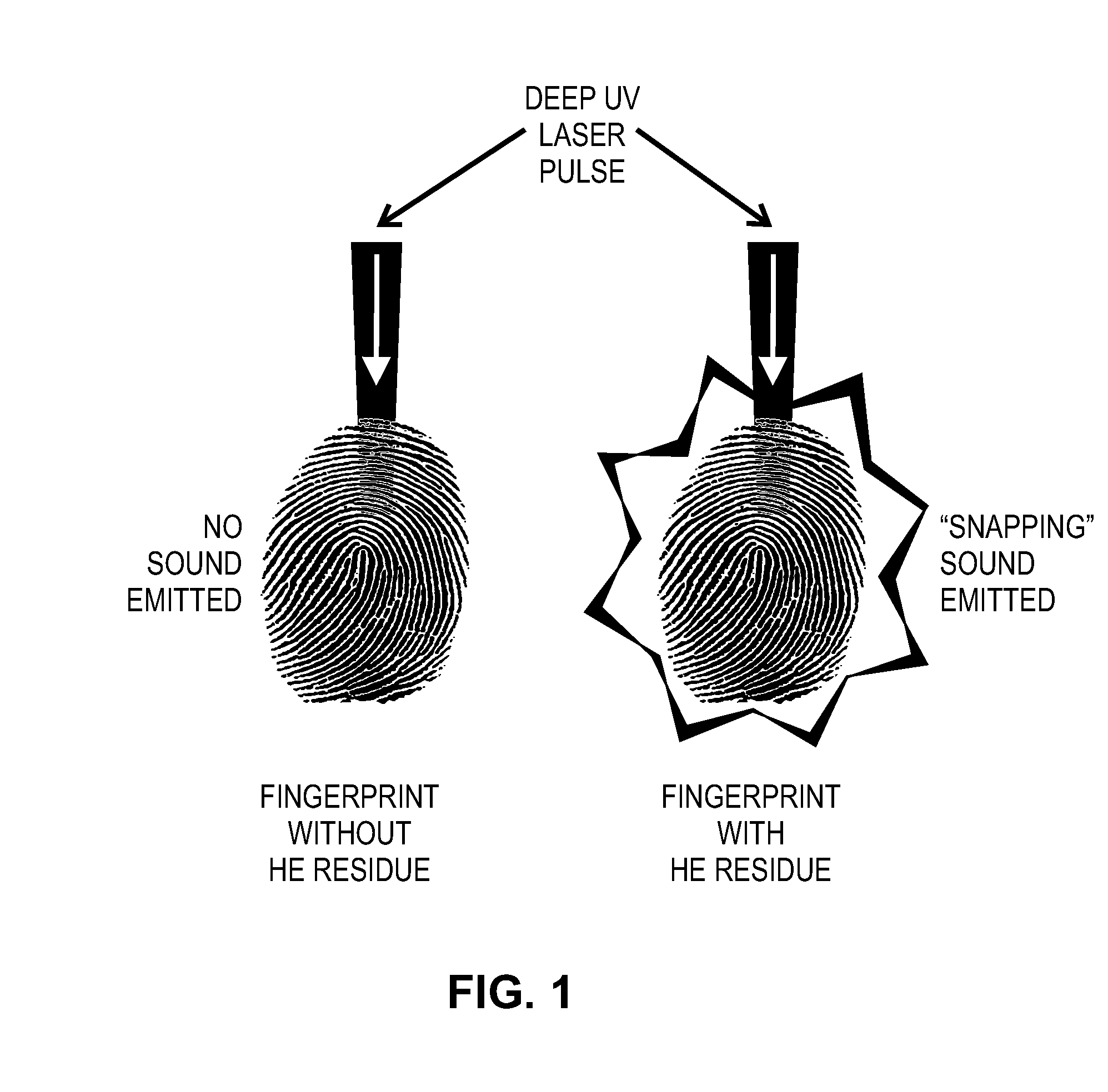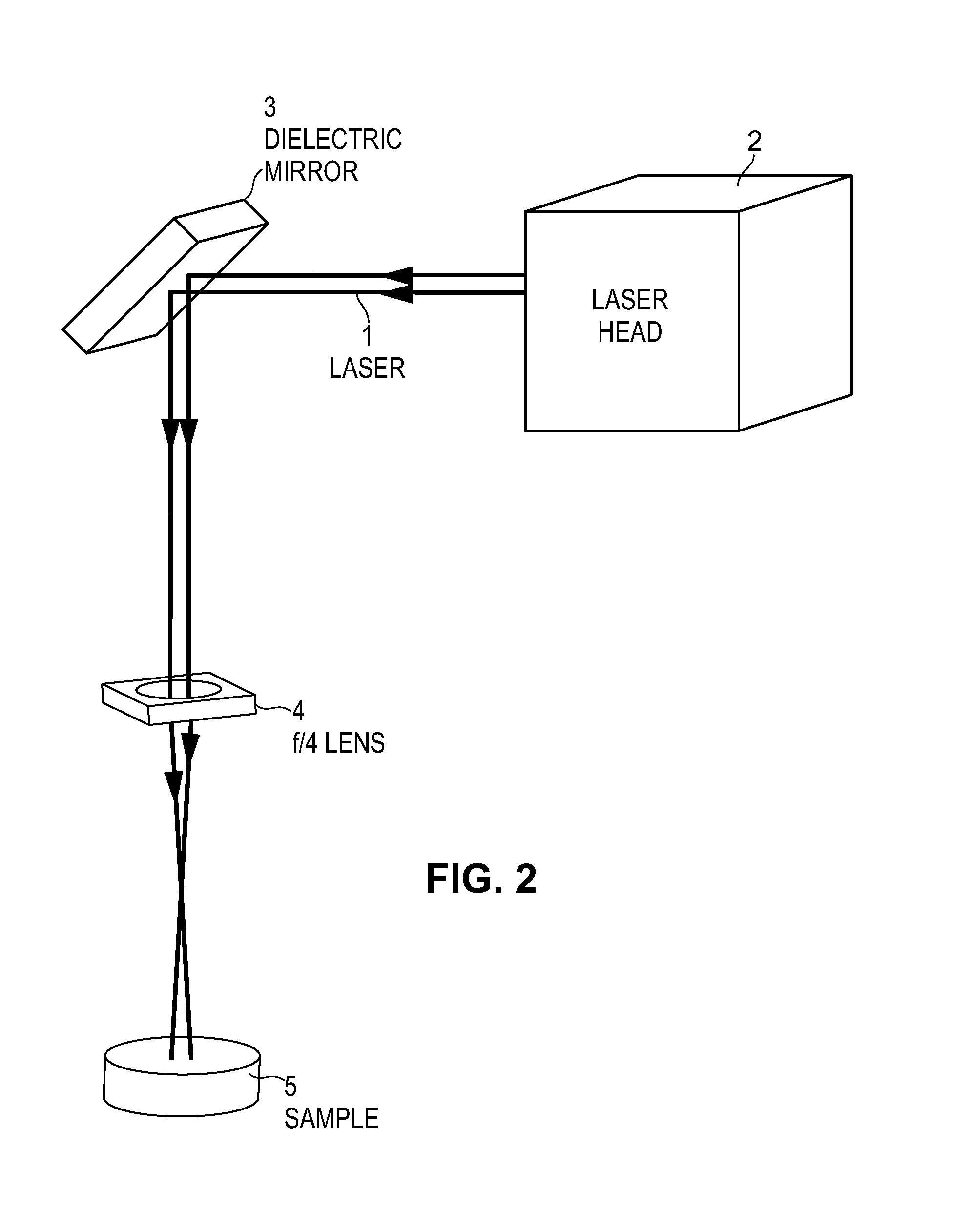Laser eye-safety method and apparatus
a safety method and laser technology, applied in the field of explosive detection, can solve the problems of limited use of this method, optical emission, detection and analysis of these emissions may require very expensive equipment, etc., and achieve the effect of improving eye safety and limiting the range to targ
- Summary
- Abstract
- Description
- Claims
- Application Information
AI Technical Summary
Benefits of technology
Problems solved by technology
Method used
Image
Examples
experimental examples
[0075]The experimental setup for the LIA measurements described in the Examples below is as shown in FIG. 2 and FIG. 3. As can be seen in FIG. 2, pulses of ultraviolet light 1 from Laser Head 2 were reflected off a 45-degree dielectric mirror 3 and directed through an f / 4 lens 4 onto a sample / target surface 5. The lens was placed such that the laser light was diverging to a diameter of 3.5 mm as it intersected the target.
[0076]LIA signals were collected using a short condensing shotgun microphone located approximately 10 meters from the target area. The microphone was connected to an amplifier that, in turn, was connected to a 500 MHz A / D data acquisition board (Acqiris Model DP235, commercially available from Agilent Technologies, Inc., Santa Clara, Calif.). The DAQ board was triggered by the laser and used to record the audio signals. FIG. 3A shows the tripod-mounted directional microphone 6 with amplifier 7. FIG. 3B depicts a view of the target 9 from the microphone 10 located 10...
example 1
LIA Measurements of Explosives in Silica Sand
[0079]LIA measurements were collected using explosives purchased from XM, a division of Van Aken International located near Los Angeles, Calif. (http: / / www.xm-materials.com / ). The explosives consisted of either TNT (trinitrotoluene), RDX, or PETN deposited on silica particles. These coated particles typically are used for training dogs to detect explosives. TNT and RDX were present at 8% by weight in their respective samples, and PETN was present at 4% by weight. Uncoated silica particles also were used, in order to reduce the weight percentages of the explosives by dilution. Samples were prepared for analysis by spreading approximately 0.6 g of material on double-sided polyethylene tape, which was attached to the underside of a 37 mm diameter aluminum sample pan. Samples were irradiated at 266 nm from a CFR-400 laser (commercially available from Quantel USA, Bozeman, Mont.).
[0080]The LIA threshold of “explosive-free” silica on tape was d...
example 2
LIA Measurements of Non-Explosive in Silica Sand
[0083]Further comparative experiments using naphthalene demonstrated that the LIA results presented in Example 1 may indeed be unique to explosives. Naphthalene is a non-explosive substance having a core molecular structure similar to that of TNT, as seen in FIG. 7. (The core structure of each molecule contains a benzene ring.)
[0084]To test the selectivity of LIA, experiments were conducted to see if adding naphthalene to silica produced LIA results different from that of TNT added to silica. A quantity of 99% pure naphthalene was ground and then mixed with silica sand to form an 8% naphthalene mixture for direct comparison with the 8% TNT coated silica sample tested in Example 1. LIA data were collected using the procedure of Example 1 on that sample and on additional mixtures with lower naphthalene concentrations, until a threshold was reached where the LIA disturbance was no longer detectable.
[0085]Experiments on these samples demon...
PUM
| Property | Measurement | Unit |
|---|---|---|
| energy | aaaaa | aaaaa |
| wavelength | aaaaa | aaaaa |
| wavelength | aaaaa | aaaaa |
Abstract
Description
Claims
Application Information
 Login to View More
Login to View More - R&D
- Intellectual Property
- Life Sciences
- Materials
- Tech Scout
- Unparalleled Data Quality
- Higher Quality Content
- 60% Fewer Hallucinations
Browse by: Latest US Patents, China's latest patents, Technical Efficacy Thesaurus, Application Domain, Technology Topic, Popular Technical Reports.
© 2025 PatSnap. All rights reserved.Legal|Privacy policy|Modern Slavery Act Transparency Statement|Sitemap|About US| Contact US: help@patsnap.com



